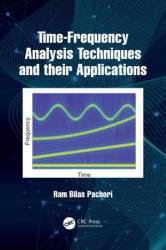Time-Frequency Analysis Techniques and their Applications
- Добавил: literator
- Дата: 23-03-2023, 21:27
- Комментариев: 0
 Название: Time-Frequency Analysis Techniques and their Applications
Название: Time-Frequency Analysis Techniques and their ApplicationsАвтор: Ram Bilas Pachori
Издательство: CRC Press
Год: 2023
Страниц: 238
Язык: английский
Формат: pdf (true)
Размер: 17.9 MB
Most of the real-life signals are non-stationary in nature. The examples of such signals include biomedical signals, communication signals, speech, earthquake signals, vibration signals, etc. Time-frequency analysis plays an important role for extracting the meaningful information from these signals. The book presents time-frequency analysis methods together with their various applications.
The basic concepts of signals and different ways of representing signals have been provided. The various time-frequency analysis techniques namely, short-time Fourier transform, wavelet transform, quadratic time-frequency transforms, advanced wavelet transforms, and adaptive time-frequency transforms have been explained. The fundamentals related to these methods are included. The various examples have been included in the book to explain the presented concepts effectively. The recently developed time-frequency analysis techniques such as, Fourier-Bessel series expansion-based methods, synchrosqueezed wavelet transform, tunable-Q wavelet transform, iterative eigenvalue decomposition of Hankel matrix, variational mode decomposition, Fourier decomposition method, etc. have been explained in the book. The numerous applications of time-frequency analysis techniques in various research areas have been demonstrated.
This book covers basic concepts of signals, time-frequency analysis, and various conventional and advanced time-frequency analysis methods along with their applications. The set of problems included in the book will be helpful to gain an expertise in time-frequency analysis. The material presented in this book will be useful for students, academicians, and researchers to understand the fundamentals and applications related to time-frequency analysis.
The organization of this book is as follows:
Chapter 1 introduces the basics of signals, which includes definition and classification of signals. Various important signals are also discussed which can be found to be helpful in analysis of real-time signals. At the end of this chapter, various types of signal operations are discussed which can be performed on a signal during analysis.
Chapter 2 presents the idea of representation of signals in terms of some fundamental or basic set of orthogonal signals. Least square interpretation of the signal representation is also discussed. Concept of finality of coefficients is discussed for signal representation in terms of orthogonal basis functions. Concept of sampling is discussed as a signal representation in terms of impulses. Also, Fourier analysis techniques are presented for frequency-domain analysis of periodic and aperiodic signals. Further, Fourier-Bessel series expansion (FBSE) is explained in detail for the analysis of non-stationary signals.
Chapter 3 explains the steps involved in various time-domain and frequency-domain signal characteristics like, mean time, duration, mean frequency, and frequency spread. Using these signal characteristics, the uncertainty principle and Heisenberg box representation are discussed for the signals localized in both time- and frequency-domain. Also, for amplitude-frequency modulated (AFM) signals, the extraction of amplitude envelope (AE) and instantaneous frequency (IF) functions using discrete energy separation algorithm (DESA) and Hilbert transform separation algorithm (HTSA) is explained. The HTSA-based Hilbert spectral analysis (HSA) is also explained for obtaining the time-frequency representation (TFR) of a signal.
Chapter 4 discusses the short-time Fourier transform (STFT) for the analysis of non-stationary signals. Various interpretations of STFT are discussed along with its various properties. Filter bank structure of STFT is discussed. Short-frequency Fourier transform (SFFT) and its squared magnitude, known as sonogram are discussed.
Chapter 5 presents the theory of wavelet-based analysis of non-stationary signals along with its various properties. Energy distribution in time-scale plane, i.e., scalo-gram of a signal using wavelet transform is presented. Also, the concept of multiresolution for discrete wavelet transform (DWT) is discussed. A filter-bank-based DWT is presented at the end of this chapter.
...
Chapter 9 presents various applications of techniques considered in previous chapters. Various signals considered in this chapter are biomedical signals and im- ages, speech signals, communication signals, power-quality signals, financial signals, vibration signals, and signals occurred in chemical engineering and ocean engineering.
Скачать Time-Frequency Analysis Techniques and their Applications
[related-news] [/related-news]
Внимание
Уважаемый посетитель, Вы зашли на сайт как незарегистрированный пользователь.
Мы рекомендуем Вам зарегистрироваться либо войти на сайт под своим именем.
Уважаемый посетитель, Вы зашли на сайт как незарегистрированный пользователь.
Мы рекомендуем Вам зарегистрироваться либо войти на сайт под своим именем.
